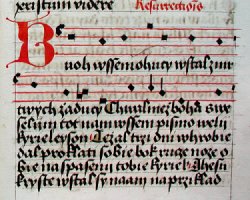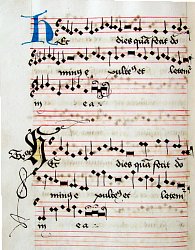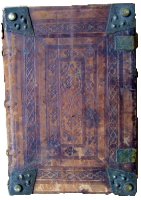Kutna Hora's Musical Manuscripts of 15. and 16. Centuries
The Latin gradual 1
This source is deposited in the State District Archive in Kutna Hora. By the typeface and style of notation and
the watermarks we can assume that it originated at the turn of the 15th and 16th centuries [
7].
The gradual is illuminated with floral ornaments in gold and silver. However, the ornamentation
is not done very carefully. No figural illuminations are included here. The illumination can be dated to
the early 16th century [
26].
The gradual contains one-voice chorals and hymns for the church year written in choral rhombic
notation and black mensural notation on four lines. It was written by at least two scribes,
the „older hand“ fits the 15th century, the „newer“ the beginning of the 16th.
At the end of the book is a set of songs that were well-known in those days
(
Ave yerarhia, Imperatrix gloriosa, In novo anno, Resurgenti nazareno,
Nobis est natus hodie, Jesus Christus nostra salus, Deus omnipotens).
The only two songs with Czech texts are
Svatý Václave
(Saint Wenceslas) a
Buoh všemohúcí (God Almighty).
All the songs are one-voice, the only two-voice composition is Hoc dies quam fecit.
(Its Czech mutation is contained in the Gradual of the Czech Museum of
Silver as
Tento den zvláštní (This special day).)

The song Buoh všemohúcí

The song In hoc anni circulo
Although we have no evidence of its connection to Kutna Hora, there is no evidence that it could not
belong to a literary brotherhood in one of Kutna Hora’s churches.

The song Hec dies quam fecit








